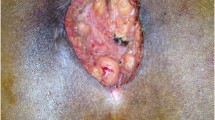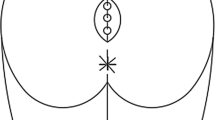Abstract
Background
Although various methods have been described for surgical treatment of pilonidal sinus disease, which is best is under debate. Tension-free techniques seem to be most ideal. We aimed to evaluate the effects of two tension-free methods in terms of patient satisfaction, postoperative complications, and early recurrence.
Methods
A group of 122 patients were prospectively included in the study. Patients were divided into two groups based on the operative method used: Limberg flap or Bascom cleft lift. Quality of life scores, pain scores, length of time for healing, hospital stay, surgical area-related complications, excised tissue weight, and early recurrence information were evaluated.
Results
Follow-up of patients in each group was completed. Patients in the Bascom cleft lift group had shorter operation duration, less excised tissue weight, better bodily pain score, and less role limitation due to physical problems score on postoperative day 10. There was no statistically significant difference between groups for the other criteria.
Conclusions
Although both techniques provided good results during the early period, the Bascom cleft lift procedure is a reliable technique that provides shorter operation duration and better quality of life during the early postoperative period.



Similar content being viewed by others
References
Can MF, Sevinc MM, Hancerliogullari O et al (2010) Multicenter prospective randomized trial comparing modified Limberg flap transposition and Karydakis flap reconstruction in patients with sacrococcygeal pilonidal disease. Am J Surg 200:318–327
McCallum IJ, King PM, Bruce J (2008) Healing by primary closure versus open healing after surgery for pilonidal sinus: systematic review and meta-analysis. BMJ 336:868–871
Topgül K (2010) Surgical treatment of sacrococcygeal pilonidal sinus with rhomboid flap. J Eur Acad Dermatol Venereol 24:7–12
Bascom J, Bascom T (2007) Utility of the cleft lift procedure in refractory pilonidal disease. Am J Surg 193:606–609
Abdelrazeq AS, Rahman M, Botterill ID et al (2008) Short-term and long-term outcomes of the cleft lift procedure in the management of nonacute pilonidal disorders. Dis Colon Rectum 51:1100–1106
Petersen S, Aumann G, Kramer A et al (2007) Short-term results of Karydakis flap for pilonidal sinus disease. Tech Coloproctol 11:235–240
Brazier JE, Harper R, Jones NMB et al (1992) Validating the SF-36 health survey questionnaire: new outcome measure for primary care. BMJ 305:160–164
Mentes O, Bagci M, Bilgin T et al (2008) Limberg flap procedure for pilonidal sinus disease: results of 353 patients. Langenbecks Arch Surg 393:185–189
Bascom J, Bascom T (2002) Failed pilonidal surgery: new paradigm and new operation leading to cures. Arch Surg 137:1146–1150
Ertan T, Koc M, Gocmen E et al (2005) Does technique alter quality of life after pilonidal sinus surgery? Am J Surg 190:388–392
Rao MM, Zawislak W, Kennedy R et al (2010) A prospective randomised study comparing two different modalities for chronic pilonidal sinus. Int J Colorectal Dis 25:395–400
Tezel E, Bostanci H, Anadol AZ et al (2009) Cleft lift procedure for sacrococcygeal pilonidal disease. Dis Colon Rectum 52:135–139
Rushfeldt C, Bernstein A, Norderval S et al (2008) Introducing an asymmetric cleft lift technique as a uniform procedure for pilonidal sinus surgery. Scand J Surg 97:77–81
Dudink R, Veldkamp J, Nienhujis S et al (2011) Secondary healing versus midline closure and modified Bascom natal cleft lift for pilonidal sinus disease. Scand J Surg 100:110–113
Karydakis GE (1992) Easy and successful treatment of pilonidal sinus after explanation of its causative process. Aust N Z J Surg 62:385–389
Kitchen PR (1996) Pilonidal sinus: experience with the Karydakis flap. Br J Surg 83:1452–1455
Bascom J (1980) Pilonidal disease: origin from follicles of hairs and results of follicle removal as treatment. Surgery 87:567–572
Nursal TZ, Ezer A, Calişkan K et al (2010) Prospective randomized controlled trial comparing V-Y advancement flap with primary suture methods in pilonidal disease. Am J Surg 199:170–177
Theodoropoulos GE, Vlahos K, Lazaris AC et al (2003) Modified Bascom’s asymmetric midgluteal cleft closure technique for recurrent pilonidal disease: early experience in a military hospital. Dis Colon Rectum 46:1286–1291
Nordon IM, Senapati A, Cripps NP (2009) A prospective randomized controlled trial of simple Bascom’s technique versus Bascom’s cleft closure for the treatment of chronic pilonidal disease. Am J Surg 197:189–192
Jamal A, Shamim M, Hashmi F et al (2009) Open excision with secondary healing versus rhomboid excision with Limberg transposition flap in the management of sacrococcygeal pilonidal disease. J Pak Med Assoc 59:157–160
Mahdy T (2008) Surgical treatment of the pilonidal disease: primary closure or flap reconstruction after excision. Dis Colon Rectum 51:1816–1822
Muzi MG, Milito G, Cadeddu F et al (2010) Randomized comparison of Limberg flap versus modified primary closure for the treatment of pilonidal disease. Am J Surg 200:9–14
Karakayali F, Karagulle E, Karabulut Z et al (2009) Unroofing and marsupialization vs. rhomboid excision and Limberg flap in pilonidal disease: a prospective, randomized, clinical trial. Dis Colon Rectum 52:496–502
Akin M, Gokbayir H, Kilic K et al (2008) Rhomboid excision and Limberg flap for managing pilonidal sinus: long-term results in 411 patients. Colorectal Dis 10:945–948
Doll D, Krueger CM, Schrank S et al (2007) Timeline of recurrence after primary and secondary pilonidal sinus surgery. Dis Colon Rectum 50:1928–1934
Topgul K, Ozdemir E, Kilic K et al (2003) Long-term results of Limberg flap procedure for treatment of pilonidal sinus: a report of 200 cases. Dis Colon Rectum 46:1545–1548
Petersen S, Koch R, Stelzner S et al (2002) Primary closure techniques in chronic pilonidal sinus: a survey of the results of different surgical approaches. Dis Colon Rectum 45:1458–1467
Author information
Authors and Affiliations
Corresponding author
Rights and permissions
About this article
Cite this article
Guner, A., Boz, A., Ozkan, O.F. et al. Limberg Flap Versus Bascom Cleft Lift Techniques for Sacrococcygeal Pilonidal Sinus: Prospective, Randomized Trial. World J Surg 37, 2074–2080 (2013). https://doi.org/10.1007/s00268-013-2111-9
Published:
Issue Date:
DOI: https://doi.org/10.1007/s00268-013-2111-9




